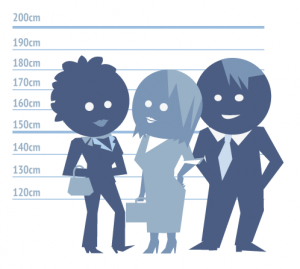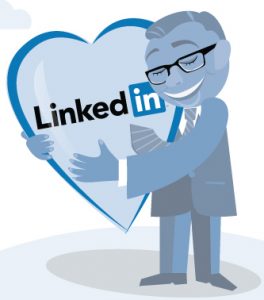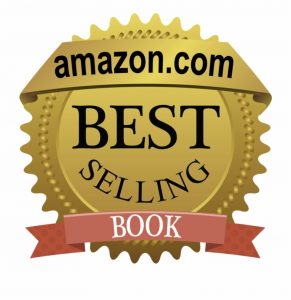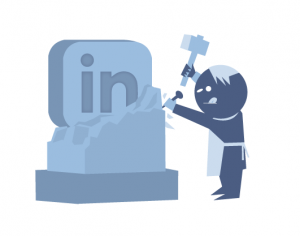On 28 January 2004, I joined the LinkedIn social media network, but what to use it for, I had no idea.
In the beginning, I thought LinkedIn was a digital version of my personal network. I only invited and accepted invitations from people that I knew. People I had met. So, for close to ten years, not much happened.
Then I got an idea.
An epiphany
I was working on my third book, Building Successful Partner Channels, and considering how big the market would be for such a title.

By then, I had invested in a professional version of LinkedIn. I was already a busy blogger and posted regularly on social media too. On 20 August 2014, I posted my first article on the new LinkedIn publishing platform.
The amount of traffic coming to my profile was reasonable, and I received a steady stream of invitations to connect. Using the extended search criteria, I found out that about four and a half million LinkedIn members had a profile matching the characteristics of my target audience for the book!
They didn’t all read business books, but it was still a considerable market if just half of them did.
I then decided to focus all my promotional efforts on LinkedIn. I also knew that I had to go rogue. Paying LinkedIn for advertising a ten-dollar book would never produce a profit, and hacking the algorithm to push my content into the home feed of my potential readers wouldn’t work either. A video of rescuing a deer in trouble may go viral. Tips on building a productive reseller channel in the software industry will not. These were the conditions on social media in 2015, and they haven’t changed.
Direct marketing
Instead, I started building my first level network with connections within the audience for the book. By the time it was ready for publication, I had about 5,000 relevant, 1st level connections.

You can write personal messages to your 1st level connections through LinkedIn, which I did. I offered them a free Kindle version of the book. When they answered YES, which was all I asked, I returned a short message including a link to the page where they had to enter their email. If they signed up before a specific date (which was my planned publication date) I would notify them when the time for downloading their free copy was up. I stopped the personal messaging activity when I had 1,000 emails on the list.
The day the book was published, the email went out to the list with a link to the Amazon page where the Kindle version was available free of charge for a week. The printed version of the book had a 50 per cent discount for the same period.
Before I reveal the results from the campaign, I will share some interesting observations from the personal message activity.
Using personal messages for sales purposes
It is a common philosophy that you shouldn’t use personal messages on LinkedIn to sell something. It turns people off. I subscribe to that perception. Submitting promotional messages through LinkedIn may also be violating local SPAM regulations, but this is indeed a grey area.

However, I only lost 18 connections during my PM campaign out of the 4,500 I managed to submit. That’s 0.4 per cent. They were either offended by being offered a free copy of a book or found it irrelevant. I had no problem seeing them leave. It was a clear win-win. And getting 1,000 signups out of the 4,500 messages was an outstanding achievement.
My conclusion about using personal messages for sales purposes is that it comes down to the relevance and nature of the offer. I was offering a free copy of a book that was relevant. No strings attached. I wasn’t asking for anything in return. I even stressed that the email list would be deleted after they received the notification. I also added double opt-in to the signup procedure.
It seems that if the message is relevant, you offer something that has genuine value and do not ask for anything in return, then most of your connections will respond positively. In this case, all they needed to do was answer YES. Those that did, received a short message with a link to the signup page. The conversion rate was close to 80 per cent!
An instant bestseller
Out of the 1,000 emails on the list, a little over 500 took advantage of the offer. Roughly 400 downloaded the Kindle version, and 100 bought the printed version at a reduced price. Within the first week of the book’s life, this activity pushed it to #1 in new releases and helped make the book #1 in its category the following week. The book instantly became a bestseller!

I started to receive personal messages from the readers, and then I asked them to rate the book and write a short review. Many of them did.
What works for me may not work for you
I reached the maximum number of connections you can have on LinkedIn in 2019. That’s 30,000. Having so many connections makes good sense when you sell books for ten dollars a pop to a market of millions.
I also post regularly on LinkedIn, Twitter, and Facebook, but you would be surprised to see how little engagement my posts achieve. Very few likes and hardly any comments. But that’s OK. I sell books every day and trust a relationship exists (although I know that correlation doesn’t prove causation!).
From time to time, I run a direct message activity (with a unilateral offer) and see an increase in book sales. I will lose around 0.5% of the connections during such a campaign, but that’s fine. It frees up slots for new, better qualified, and more active connections.
There’s plenty of generic advice on LinkedIn for using the platform. I ignore most of it. What works and what doesn’t comes down to what type of business you run and what you want to achieve. If your potential customers are on the platform, and you want to do it for revenue generation purposes, then you should invest in a LinkedIn coach to help you analyse your options, define a strategy, and set up an action plan.

Again, selling a ten-dollar product, I cannot justify investing in researching each connection. I must rely on the generic segmentation criteria that LinkedIn Sales Navigator offers. If someone works in business development, marketing, sales development, sales, or customer success in the Information Technology & Services or Computer Software industries, then my writing is relevant. If they have international activities or ambitions and use an indirect go-to-market approach, then my content is hard to ignore. Making a ten-dollar investment in a book is a simple personal decision that can be made anytime. That’s why my approach works.
Suppose you sell mission-critical, industry-specific and customisable business management solutions with a customer lifetime value north of a million dollars through a reseller channel. In that case, you will need a different approach. You will need a Sales Navigator subscription and a more granulated process.
This post was published first on the TBK Consult blog.
